Hello, dear readers! Welcome to the colorful land of Kutch, where art doesn’t just decorate walls—it breathes life into them! One of the most enchanting crafts from this region is the Mud-Mirror Work, locally known as Lippan Kaam. Imagine walking into a room where walls glimmer with tiny mirrors, surrounded by smooth clay designs shaped by hand—it’s like sunlight dancing on earth!
This traditional art form beautifully blends nature, culture, and creativity. Made using simple materials like mud, clay, and mirrors, it reflects the rustic charm and artistic spirit of Gujarat’s desert villages.
Originally used by local communities to decorate their homes and temples, this craft now shines in modern interiors too. Through every swirl and sparkle, Mud-Mirror Work tells a story—of warmth, tradition, and timeless craftsmanship passed lovingly through generations.
Historical Roots: The Story Behind the Shine
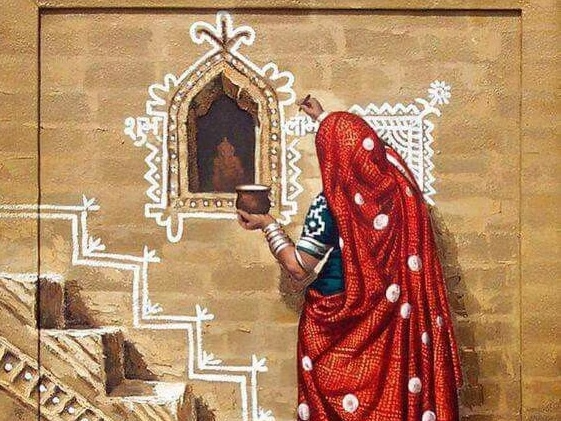
The story of Mud-Mirror Work, locally known as Lippan Kaam, dates back several centuries in the arid region of Kutch, Gujarat. This art form was born from the creativity and necessity of the local communities, especially the Rabari, Mutwa, and Kumbhar tribes, who used it to decorate their mud houses and protect their walls from heat and cracks.
Traditionally, women played a key role in developing this craft. Using mud from nearby wetlands and small pieces of mirror, they created beautiful wall designs that not only added charm but also reflected light inside their dimly lit homes. The mirrors had a practical purpose — to brighten interiors — but they soon took on a symbolic meaning, believed to ward off evil and bring positivity.
Over time, Lippan Kaam evolved from being a humble household decoration into a vibrant symbol of Kutch’s folk culture. The intricate patterns, inspired by nature, animals, and tribal life, became an expression of identity and storytelling. Today, this traditional art has found its way into modern spaces, maintaining its rustic soul while shining with new artistic energy — a perfect blend of heritage and contemporary beauty.
✨ Mud-Mirror Work from Kutch: Materials and Making Process
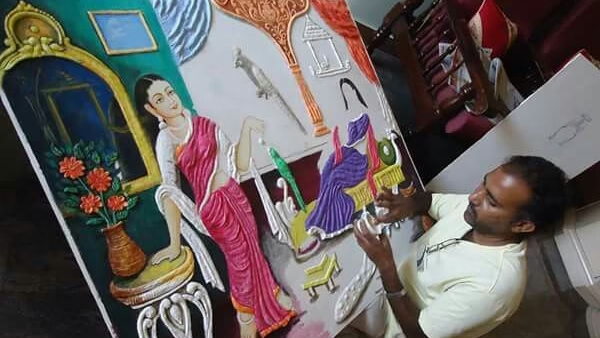
The beautiful Mud-Mirror Work of Kutch is a living example of how art, earth, and culture come together to create something timeless. Found mostly in Gujarat’s Kutch region, this art form—locally called Lippan Kaam—uses simple, natural materials to create stunning wall decorations that shimmer with mirror reflections and earthy textures.
Let’s explore what goes into making this art and how it comes to life step by step.
🌿 Materials Used in Mud-Mirror Work
Mud-Mirror Work stands out because it is made using materials that are both eco-friendly and locally available. Here’s what artisans use to craft these sparkling murals:
1. Mud and Clay (The Soul of the Art)
- The base material for this craft is locally available mud or clay, often mixed with camel dung to increase strength and flexibility.
- This mixture keeps walls insulated—cool in summer and warm in winter—making it both artistic and functional.
- The mud gives the artwork its natural brown tone and smooth texture for mirror setting.
2. Camel Dung (The Natural Binder)
- Camel dung acts as a natural adhesive and helps prevent cracking when the mud dries.
- It also gives elasticity to the paste, allowing artisans to mold it into intricate patterns by hand.
3. Fine Clay Powder and Lime (For Durability)
- Lime or fine clay is mixed into the mud to make the paste smoother and longer-lasting.
- It provides a fine finish to the artwork, ensuring the surface remains crack-free and polished.
4. Tiny Mirrors (The Sparkle of Kutch)
- Small round or diamond-shaped mirrors, called aabhla, are the signature of this art form.
- These mirrors catch and reflect sunlight, making walls shimmer beautifully.
- Traditionally, they were handmade from real glass; now, modern artisans also use mirror sheets or acrylic for durability.
5. Natural and Synthetic Colors (For Decoration)
- Traditionally, natural pigments from plants and minerals were used to color the mud.
- Today, artisans often use acrylic paints or oxide colors to add a vibrant touch without losing the earthy feel.
6. Tools and Wooden Molds (For Detailing)
- Simple tools like wooden sticks, knives, or fingers are used to shape the designs.
- Some artisans use handmade wooden molds to press repeated motifs like flowers or peacocks for precision.
🪞 Steps of Making Mud-Mirror Work
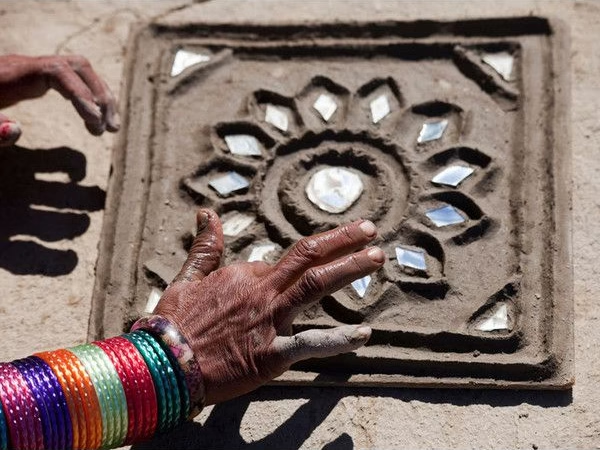
Creating Mud-Mirror Work is not just a process—it’s an experience that blends patience, skill, and tradition. Let’s see how the magic unfolds, step by step:
1. Preparing the Mud Paste
- Artisans start by mixing mud, camel dung, and water to form a thick, smooth paste.
- Sometimes lime or clay powder is added to enhance strength and texture.
- The mixture is left to rest for a few hours, allowing it to reach the right consistency for shaping.
2. Smoothing the Wall Surface
- The surface or wall is cleaned and slightly moistened to help the paste stick better.
- A thin base layer of mud paste is applied evenly over the wall to create a smooth foundation.
3. Drawing the Design
- Once the base is ready, artisans draw designs directly onto the wall using chalk or fingers.
- Common patterns include geometric shapes, flowers, peacocks, suns, and traditional motifs that represent nature and spirituality.
4. Shaping with Mud
- The prepared paste is rolled into thin coils or strips by hand.
- These strips are carefully placed on the drawn design to form raised patterns.
- The process requires precision, as each curve and line must be smooth and proportionate.
5. Setting the Mirrors
- Tiny mirrors are then gently pressed into the wet mud patterns.
- Artisans place them strategically—either in the center of motifs or along borders—to enhance light reflection.
- The shine of the mirrors brings life to the earthy tones, creating a magical play of light and texture.
6. Drying and Finishing Touches
- Once the mirrors are fixed, the artwork is left to dry naturally for one to two days.
- After drying, the design becomes firm and durable.
- Some artisans apply a thin coat of color wash or paint to highlight the designs.
7. Polishing and Detailing
- The final touch involves light polishing to make the mirrors gleam brighter.
- Additional decorative lines or dots may be added for artistic depth.
Symbols and Motifs in Mud-Mirror Work from Kutch
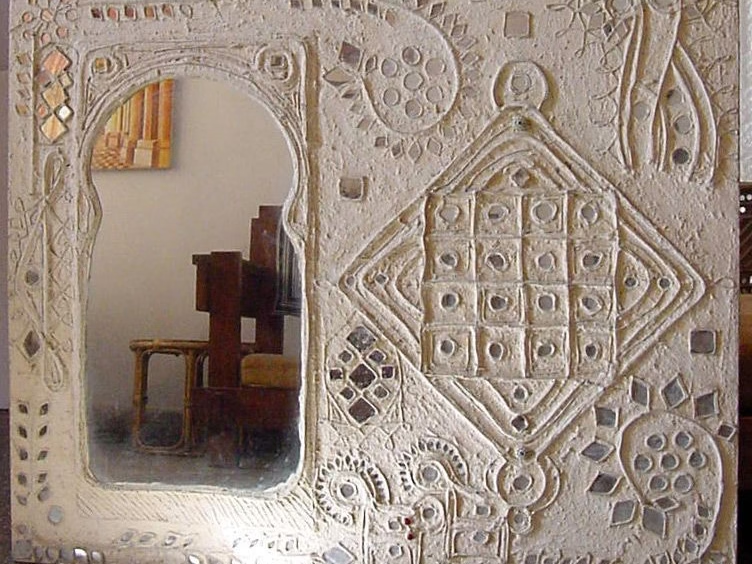
When you walk into a traditional Kutch home, you’re immediately greeted by walls that sparkle back at you. The mirrors catch the sunlight, the earthy textures glow softly — and each curve, each symbol has something to say. This is Mud-Mirror Work, or Lippan Kaam, an ancient craft where motifs aren’t random decorations — they are reflections of culture, belief, and nature.
🌿 1. Nature as the Eternal Muse
Nature has always been the soul of Kutch’s art forms. In Mud-Mirror Work, it’s seen in patterns that echo life in the desert — simple, earthy, and full of meaning.
- Peacock (Mor):
- The peacock is a favorite motif, symbolizing beauty, joy, and divine connection.
- It represents monsoon and prosperity — a hopeful sign in the dry landscape of Kutch.
- Artisans often place peacocks around doorways to invite good fortune and happiness.
- The peacock is a favorite motif, symbolizing beauty, joy, and divine connection.
- Tree of Life:
- A recurring design in Lippan Kaam, it represents growth, fertility, and eternal life.
- The tree connects earth and sky, much like how the art itself connects the physical wall with the spiritual world.
- Each branch and leaf is carefully carved, then adorned with small mirrors to reflect “life’s light.”
- A recurring design in Lippan Kaam, it represents growth, fertility, and eternal life.
- Flowers and Creepers:
- Floral motifs bring freshness and beauty to the desert’s monotone backdrop.
- Flowers symbolize grace, positivity, and renewal, while creepers denote continuity and endurance.
- These are often arranged in circular or spiral patterns to show the cycle of life.
- Floral motifs bring freshness and beauty to the desert’s monotone backdrop.
☀️ 2. Celestial Inspirations: Sun, Moon, and Stars
In Kutch’s wide open skies, celestial symbols hold deep spiritual meaning.
- The Sun (Surya):
- Represents energy, light, and protection.
- Often placed at the center of wall designs or near entrances to bring warmth and ward off negativity.
- The circular sun motif is surrounded by mirror chips — symbolizing the spreading of light.
- Represents energy, light, and protection.
- The Moon (Chand):
- Embodies peace, calmness, and balance.
- Commonly paired with star motifs to reflect the desert’s serene night sky.
- The moon also represents femininity — a tribute to the women artisans who primarily create this art.
- Embodies peace, calmness, and balance.
- Stars (Tara):
- Mirrors are arranged in star-like clusters to mimic constellations.
- They symbolize guidance and divine presence, a comforting sign for travelers in the desert.
- Mirrors are arranged in star-like clusters to mimic constellations.
🕊️ 3. Animal Motifs: Symbols of Strength and Spirit
Kutch’s people share a close bond with animals — their companions in harsh desert life. This connection finds voice in Mud-Mirror patterns.
- Camel (Oont):
- Known as the “ship of the desert,” the camel represents endurance, strength, and survival.
- Often seen in horizontal designs, reflecting the long journeys across the Rann.
- Known as the “ship of the desert,” the camel represents endurance, strength, and survival.
- Elephant (Hathi):
- Symbolizes royalty, stability, and wisdom.
- These motifs are usually grand and detailed, showing the artisan’s pride and patience.
- Symbolizes royalty, stability, and wisdom.
- Birds in Flight:
- Birds like parrots, doves, and sparrows appear as symbols of freedom and communication.
- They represent the wish for a harmonious and connected community.
- Birds like parrots, doves, and sparrows appear as symbols of freedom and communication.
🕉️ 4. Spiritual and Geometric Patterns
Not all motifs depict living things. Some are abstract, rooted in geometry, symmetry, and spirituality.
- Mandala and Circular Designs:
- Represent unity, wholeness, and the cycle of life.
- The mirrors placed in perfect symmetry radiate balance and mindfulness.
- Represent unity, wholeness, and the cycle of life.
- Triangles and Diamonds:
- Triangles are symbols of energy and motion, while diamonds signify stability and protection.
- These are often combined to create rhythmic border patterns around larger artworks.
- Triangles are symbols of energy and motion, while diamonds signify stability and protection.
- Traditional Religious Symbols:
- Designs like Swastika (for prosperity) and Kalash (for purity) are integrated into mud walls during festivals or new constructions.
- These motifs turn ordinary homes into sacred, protective spaces.
- Designs like Swastika (for prosperity) and Kalash (for purity) are integrated into mud walls during festivals or new constructions.
💫 5. The Modern Language of Traditional Symbols
Today, artisans and designers reinterpret these age-old motifs for modern interiors and decor pieces.
- The peacock and floral motifs appear on wall panels, mirrors, and furniture.
- Geometric sunburst patterns are popular in urban homes, carrying ancient meaning into modern aesthetics.
- Even small mirrors retain their symbolic charm — reflecting light, hope, and a piece of Kutch’s desert soul wherever they shine.
🪞 Regional Variations: Different Styles Across Kutch Villages
Mud-Mirror Work, also known as Lippan Kaam, may seem uniform at first glance, but every village in Kutch adds its own magic to it. The art changes subtly with the hands and hearts of its makers—each community shaping it with unique traditions, colors, and designs.
1. Bhuj and Bhujodi: The Artistic Heart of Kutch
- Intricate Detailing: Artisans here focus on fine, symmetrical patterns made with smaller mirrors.
- Color Palette: They often use soft white or pastel mud bases, giving the designs a polished and delicate look.
- Modern Adaptations: Many Bhujodi artisans now mix traditional motifs with modern geometric art for urban interiors.
2. Gorewali and Ludia Villages: Bold and Traditional
- Cultural Influence: The designs here are more rooted in traditional Kutchi motifs—peacocks, camels, and sunbursts.
- Mirror Play: Larger mirrors are used to reflect more light, symbolizing energy and prosperity in homes.
- Clay Texture: The mud base is thicker, creating raised relief patterns that stand out on the walls.
3. Hodka and Dhordo: Desert Reflections of Simplicity
- Earthy Essence: Artisans prefer natural clay tones instead of painted colors, blending perfectly with the desert landscape.
- Minimalist Charm: Fewer motifs, but deep spiritual meaning—often inspired by nature and village life.
- Eco-Friendly Touch: Locally sourced clay and natural adhesives make the art sustainable and environment-friendly.
4. Nirona and Banni: Fusion and Experimentation
- Fusion Art: Artisans blend Mud-Mirror Work with Rogan art or bead embroidery for richer compositions.
- Creative Freedom: New-age artists here experiment with colored mirrors, adding vibrancy to traditional styles.
🛠️ Preservation and Statistics: Keeping the Tradition Alive
Mud-Mirror Work from Kutch is more than just decoration — it is a reflection of Gujarat’s earthy elegance and community identity. Yet, like many traditional crafts, it faces challenges of modernization and fading awareness. Let’s explore how this art form is being preserved and where it stands today.
🌾 1. Sustaining the Craft through Local Efforts
- Artisan Communities at Work: Villages like Ludiya, Bhuj, and Hodka remain strongholds of Mud-Mirror Work. Families here continue the practice, passing down techniques through generations.
- Self-Help Groups and Co-operatives: Women-led groups in rural Kutch actively promote this art form, combining traditional skills with modern design sensibilities.
- Skill Training Programs: The Gujarat State Handicrafts and Handloom Development Corporation conducts workshops to train new artisans and provide market linkages.
💡 2. Government and NGO Initiatives
- Craft Clusters: The Kutch Craft Cluster initiative focuses on promoting handmade crafts, with Mud-Mirror Work being one of its key segments.
- Design Collaborations: NGOs like Shrujan and Kala Raksha are helping artisans adapt to modern tastes while keeping traditional techniques intact.
- Exhibitions and Fairs: Annual events such as the Rann Utsav showcase Mud-Mirror Work, bringing artisans direct recognition and buyers.
📊 3. Current Statistics and Economic Impact
- Around 1,200–1,500 artisans across Kutch are directly engaged in Mud-Mirror Work, with women forming nearly 70% of the workforce.
- The annual sale from this craft, both local and export, is estimated at ₹8–10 crore, highlighting its growing economic importance.
- Tourist interest in handcrafted home décor has boosted sales by nearly 25% in the last five years.
🌿 Modern Adaptations: From Traditional Walls to Contemporary Decor
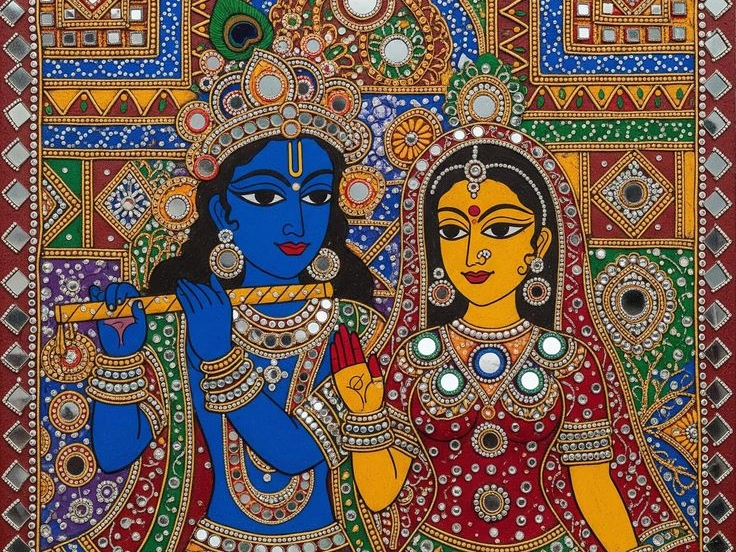
1. The Timeless Charm of Mud Mirror Work
- Mud Mirror Work, locally known as Lippan Kaam, was once used only to decorate the mud huts of Kutch.
- Traditionally, it brought warmth, beauty, and brightness to rural homes—reflecting sunlight during the day and flickering oil-lamp light at night.
- Today, its beauty has crossed boundaries, moving from simple clay walls to modern interiors, boutiques, and even luxury hotels.
2. Mud Mirror Work in Modern Interiors
- Wall Art Panels: Artisans now create detachable mud-mirror panels instead of applying them directly on walls. These panels can be framed and hung like paintings.
- Home Décor Pieces: The craft is now used in mirrors, lampshades, clocks, and photo frames—bringing a rustic yet royal touch to urban homes.
- Architectural Highlights: Designers use Mud Mirror patterns on accent walls, pillars, and even ceilings in cafes, resorts, and art galleries.
- Color Innovation: While traditional Lippan Kaam uses earthy tones, modern artists experiment with white, gold, and pastel shades to match contemporary spaces.
3. Beyond Homes: Expanding Horizons
- Fashion and Accessories: The reflective charm of Mud Mirror Work now appears on handbags, jewelry boxes, and clutches.
- Corporate and Commercial Use: Offices and hotels use the art form to add cultural warmth and an eco-friendly aesthetic to their spaces.
- Sustainable Luxury: Made from natural clay and mirrors, this craft perfectly fits the modern world’s love for sustainability and handmade artistry.
🌿 Conclusion: Mud-Mirror Work — The Shining Soul of Kutch
So folks, Mud-Mirror Work from Kutch is not just an art form; it is a living reflection of the region’s soul — simple, earthy, and radiant. Created from natural clay and tiny mirrors, this craft beautifully merges nature’s rawness with human imagination.
Every piece, whether adorning the walls of a village hut or the interiors of a modern home, tells a silent story of tradition, identity, and pride.
Also read: Pattachitra Painting of Odisha: Tales Etched on Timeless Cloth

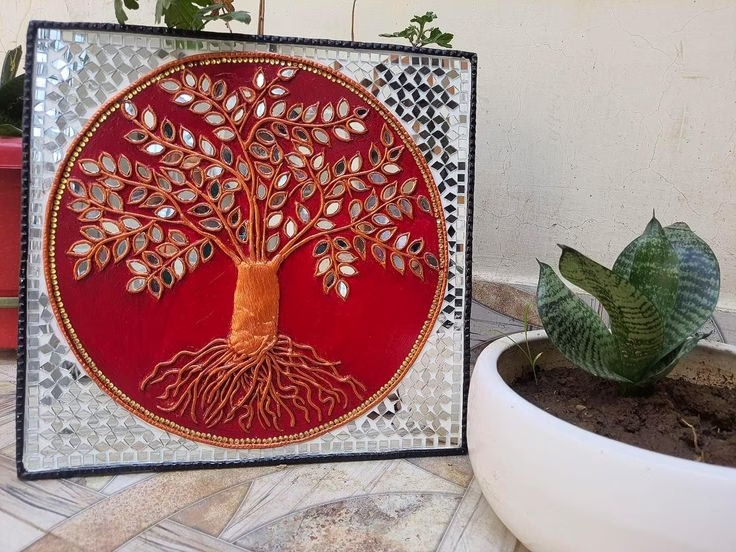
Leave a Reply